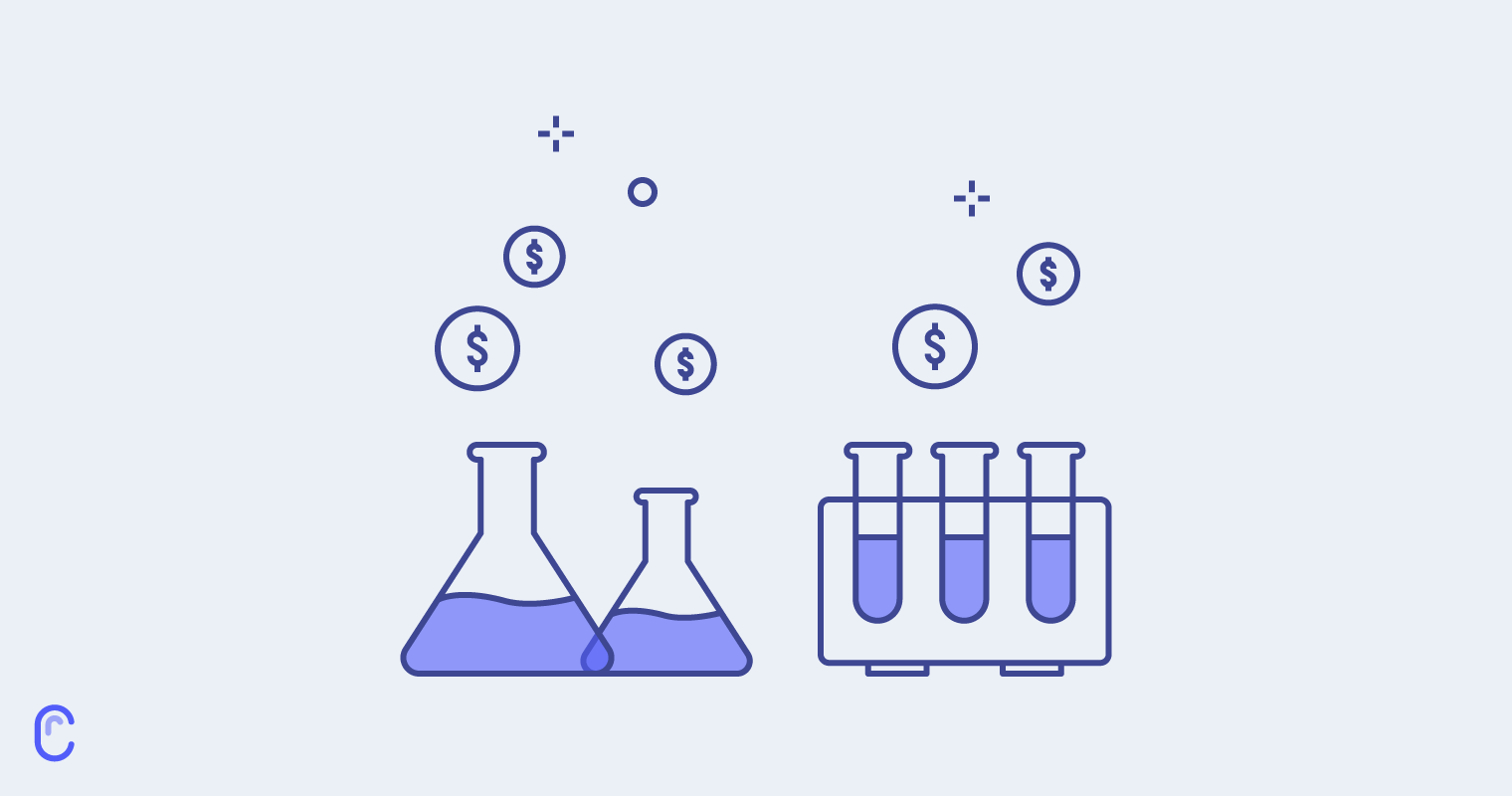Your pricing strategy is as important as marketing or product development. The cost of your product or service can make or break its success in the market.
This article will discuss the complex issue of product pricing. And, we’ll look at how to experiment with your pricing strategy. Let’s dive in.
Why you should experiment with product pricing
Any business must determine the best price for its product to be successful.
It sounds effortless, but it’s challenging in practice. If you charge too much, you might reduce the demand for your product. Charge too little, and customers might think your product is substandard.
Pricing is a delicate balancing act between value and profits. That’s why pricing experiments are so important. By testing different strategies and gathering customer feedback, you can find a price point that maximizes revenue.
5 pricing strategies
We’ve established why you should do pricing experiments. Now, let’s look at a few you can try.
1. Comparative pricing
Comparative pricing involves comparing the prices of your product with a competing product.
It’s a good way to set customer expectations. You can emphasize the price and quality of your product so customers will go for it as the cheaper option.
eCommerce and SaaS businesses use price comparisons all the time. For example, Amazon provides comparative pricing for all products on the site:
As the owner of a marketplace, the goal of Amazon is to generate sales. The company’s goal is to help visitors find the best product to fit their budget.
If you offer only a few products or services, it’s best to use comparative pricing sparingly. The goal is to show how your product or service provides more value for money than a competitor.
New entrants usually win customers by promoting their product as being cheaper.
Companies will highlight comparative pricing on sales pages or in marketing material.
The example above is from Systeme.io, a Clickfunnels competitor. The article highlights the higher cost of Clickfunnels compared to competing solutions.
Cheaper solutions attract customers on a tighter budget or who are price sensitive.
But, as a warning: This market is also likely to switch to a competitor that offers even lower prices.
2. Anchor pricing
Anchor pricing is almost identical to comparative pricing, with one crucial difference: You compare your product against more expensive options instead of direct competitors. Anchor pricing is common among both eCommerce and SaaS businesses.
You can look at Amazon again as an example.
If you look up Amazon Echo, you’ll see the full product range anchored by price point:
Most SaaS businesses use anchor pricing to help people compare plans.
For example, here is the pricing model that we use at Right Inbox.
The yellow button in the center emphasizes the value of the annual plan compared to the monthly plan. Most SaaS businesses use some variation of this strategy.
3. Item bundling
Item bundling is a strategy that involves selling a set of related items together at a discount.
This strategy helps you achieve economies of scale and quick product turnover. Still, you need to ensure that the products you’re bundling still have value if purchased on their own.
In the SaaS space, Clickfunnels is one of the best examples of a company that uses item bundling.
On the pricing page, they list 20+ information products you can access if you sign up for the $297 Platinum plan.
The idea is to provide an overload of value for the reader to incentivize them to pick your favored package. Few companies imitate the strategy implemented by Clickfunnels, even though it is effective.
4. Charm pricing
Charm pricing is also known as the rule of 9. Instead of rounding your price off to an even number, you make it a lower odd number.
For example, under this principle, more people will buy an item at $14.95 than at $15. Or, in the case of GetResponse’s pricing plans, $49 and $99 rather than $50 and $100.
Why does charm pricing work? Some believe that the human brain recognizes only the lower value and sees it as better value for money. Others think that using a specific value is the same as offering a discount.
5. Hidden pricing
Hidden pricing is the final pricing strategy you might come across.
As the name suggests, this pricing model is where you don’t share a product or service cost. As far as pricing models go, it’s one of the less common ones. But, some SaaS companies do use the hidden pricing model.
A nice example of such a company is the blogger outreach tool Pitchbox. There are no price plans on the website. The only way to find out more about the tool is to book a demo.
Pitchbox doesn’t have a price plan because they claim that all their plans are custom-priced. Based on my understanding, their plans are a bit more expensive than others. But, it’s a strategy that works for them.
One of the great things about this model is that a prospect has to enter your sales funnel to see what you offer. You are much more likely to convert a customer on a demo. Second, hiding the price will allow you to charge a premium rate. This helps you provide better customer service and invest in product development.
3 steps to performing a systematic pricing experiment
Doing a pricing experiment is a bit like doing a science lab experiment in high school.
You need to set clear goals, take a careful and deliberate approach, and gather the necessary data.
Here are the steps you need to follow when you perform a pricing experiment:
1. Consider your situation and discuss goals
Each of the strategies we discussed have their own results, advantages, and drawbacks.
You’ll first have to assess your product and decide how you want to change your price structure.
A logical starting point for this approach is to conduct competitor analysis. You should see how much your competitors charge and what features they offer. Document your findings and share the results.
Once you’ve done your analysis, you need to know where you want to position your product. Do you want to be the most expensive solution, the cheapest option, or something in the middle? You should choose a pricing strategy that fits your positioning.
As you do this exercise, consider the following questions:
- How will you roll out the new pricing?
- Will you charge all customers the new rate or only new customers?
- How many customers will you need to maintain your profits?
It’s important to remember that dropping your prices won’t mean higher demand for your goods or services. Conversely, raising prices might result in fewer customers that bring higher profits.
Be sure to watch out for internal discussions about your strategies. You are probably going to get feedback from your customer service or business development team about your new pricing models. These discussions can give you a lot of valuable insight that you can apply to pricing. You can use Gmail notes to keep track of your email discussions, for example.
2. Set out the methodology
The next step in the process is to define your goals, how you want to carry out the change, and how to track results.
The first step is to set out your goals for your product pricing experiments. It’s a good idea to use the SMART goals framework.
A SMART goal could be something like:
Increase gross quarterly revenue by 5% by implementing a new pricing strategy.
That’s a pretty straightforward goal to measure.
Next, you need to consider how to execute these changes. Changing the cost of your service is a big deal. If you suddenly start charging your existing customers $5 more, they will complain. The same customers will also complain if they discover that others pay less for the same product.
The best approach when running any type of pricing experiment is to be transparent about it. For example, you can tell customers that you are selling the product at a special price for a limited time. Clear communication with your audience can generate a lot of goodwill.
3. Run the experiment and observe carefully
The final stage of any experiment is observation. Change one price, see how the market reacts, then record your findings. Repeating this process will give you a good idea of market preferences.
The key indicators you need to track are:
- Sales volume
- Total revenue
- Profit
These three aren’t synonymous to each other. In fact, a high sales volume might mean having to sacrifice profits by offering very low prices.
At the end of your experiment, you have to make some hard decisions. Are you fine with lowering prices to increase sales volume or do you prefer higher profits? These decisions will depend a lot on the goals you set at the start of the experiment.
Bottom line
Pricing is one of the most important considerations when setting a product strategy. You need to be thorough and deliberate as you create a pricing model for your brand.
When you run a product pricing experiment, start by doing competitor analysis. Next, set your goals and decide on your approach. Finally, track your KPIs so you can see if your hypothesis yields positive results.







